
Solution to the overflow problem: The correct use of overflow requires specific code examples
Introduction:
In the field of programming, overflow problems are one of the common bugs one. Overflow problems occur when a program attempts to store a value that exceeds the range allowed by the variable type. This can lead to incorrect calculations of data or even system crashes. In order to solve this problem, developers need to use the overflow mechanism correctly to ensure the stability and reliability of the program.
1. The dangers of overflow
- Data errors: When a variable cannot accommodate a value beyond its range, the content stored in the variable will be truncated or changed, resulting in data errors. calculate. For example, if you store a value greater than 2^31-1 in a 32-bit integer, the result will be a negative number.
- Program crash: When a program attempts to allocate space beyond the available memory range, the operating system may forcefully close the program, causing the program to crash or terminate abnormally.
2. Overflow solution
- Check the input: Before processing the input data, the input should be verified and verified. For example, when receiving user input, you should check whether the input is legal and ensure that it does not cause overflow problems. You can use if conditional statements to check for edge cases, or try-catch blocks to catch exceptions.
- Use appropriate data types: Choosing appropriate data types to store data is an important step in avoiding overflow problems. If the range of stored data may exceed the range of the integer type, consider using long or floating point types. Additionally, some programming languages provide unsigned integer types that can store a larger range of positive numbers.
- Defining the value range: During the programming process, you can explicitly set the value range of the variable. For example, if you need to store the value of a variable between 0 and 100, you can use conditional statements to limit the value range of the variable, and issue a warning or error when the input exceeds the range.
- Use overflow checking: Some programming languages provide built-in mechanisms to detect overflow problems. For example, Java's numerical types automatically check for overflow during operations. When dealing with numerical operations, you can use the assert statement to ensure that the results are within a reasonable range.
3. Specific code examples
The following are specific code examples of how to use the overflow mechanism to avoid overflow problems in some common programming languages:
Java:
int a = Integer.MAX_VALUE; int b = Integer.MAX_VALUE + 1; assert b < a : "溢出错误";
Copy after login
Python:
import sys a = sys.maxsize b = a + 1 assert b < a, "溢出错误"
Copy after login
C:
#include #include int main() { int a = std::numeric_limits::max(); int b = a + 1; assert(b < a && "溢出错误"); return 0; }
Copy after login
Summary:
Overflow problem is one of the common bugs in programming, which may lead to incorrect calculation of data and system crash. In order to solve this problem, developers should handle input data appropriately, choose appropriate data types, define the value range of variables, and use overflow checking mechanisms. By using the overflow mechanism correctly, developers can ensure the stability and reliability of the program and improve the quality of the program.
The above is the detailed content of An effective solution to overflow problems: Correct application of the overflow attribute. For more information, please follow other related articles on the PHP Chinese website!






